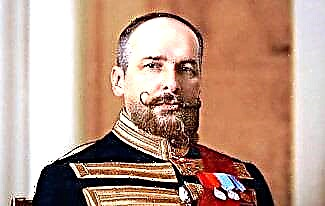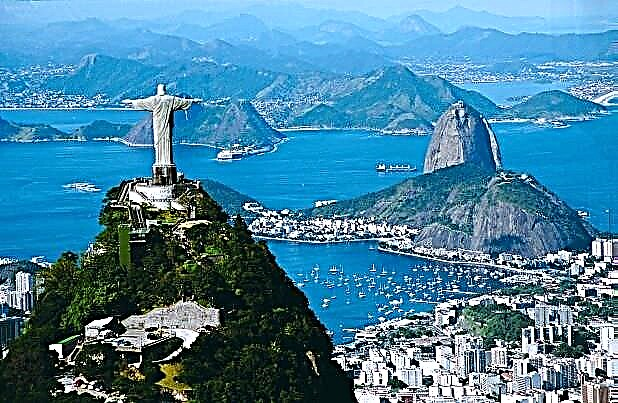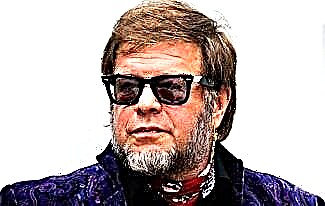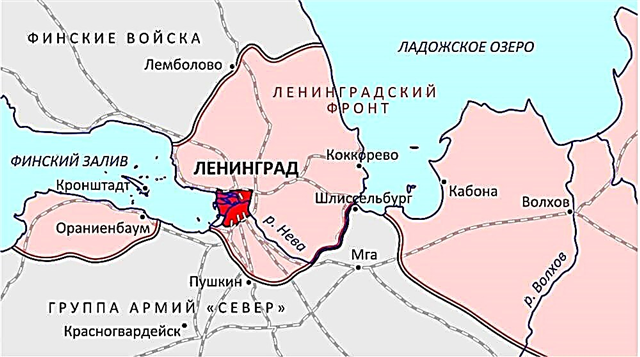The life of any talented artist is full of contradictions. The second, on the contrary, can get everything conceived, but not have a piece of bread. Someone would be recognized as a genius if they were born 50 years earlier or later, and are forced to be in the shadow of a more talented colleague. Or Ilya Repin - he lived a wonderful fruitful creative life, but at the same time he was frankly unlucky with his families - his wives constantly played, as biographers write, “short novels” on the side.

So the artist's life is not only a brush in his right hand, but an easel in his left (by the way, Auguste Renoir, having broken his right arm, switched to his left, and his work did not become worse). And pure creativity is the lot of a few.
1. The largest of the "serious" oil paintings is Tintoretto's "Paradise". Its dimensions are 22.6 x 9.1 meters. Judging by the composition, the master did not really believe that eternal happiness awaits those who are in paradise. With a total canvas area of just over 200 m2 Tintoretto has placed over 130 characters on it - "Paradise" looks like a subway car at rush hour. The painting itself is in Venice in the Doge's Palace. In Russia, in St. Petersburg, there is a version of the painting, painted by a student of Tintoretto. From time to time, modern paintings appear, the length of which is calculated in kilometers, but such crafts can hardly be called paintings.

2. Leonardo da Vinci can be considered the “father” of painting in the usual form of the majority of people. It was he who invented the sfumato technique. The contours of the figures, painted using this technique, look a little blurry, the figures themselves are natural and do not hurt the eyes, as in the canvases of Leonardo's predecessors. In addition, the great master worked with the thinnest, micron-sized layers of paint. Therefore, his characters look more alive.

Soft lines in a painting by Leonardo da Vinci
3. It looks incredible, but for 20 years from 1500 to 1520, three of the greatest painters simultaneously worked in Italian cities: Leonardo da Vinci, Raphael and Michelangelo. The oldest of them was Leonardo, the youngest Raphael. At the same time, Rafael survived Leonardo, who was 31 years older than him, just less than a year. Raphael
4. Even great artists are not alien to ambition. In 1504, in Florence, a battle took place between Michelangelo and Leonardo da Vinci. Craftsmen, who could not stand each other, had to paint two opposite walls of the Florentine assembly hall. Da Vinci wanted to win so much that he was too clever with the composition of the paints, and his fresco began to dry and crumble in the middle of the work. At the same time, Michelangelo presented cardboard - in painting it is something like a rough draft or a small model of a future work - to look at which there were queues. Technically Leonardo lost - he quit his job and left. True, Michelangelo did not complete his creation either. He was urgently summoned by the Pope, and at that time few dared to neglect such a challenge. And the famous cardboard was later destroyed by a fanatic.
5. The outstanding Russian artist Karl Bryullov grew up in a family of hereditary painters - not only his father and grandfather were involved in art, but also his uncles. In addition to inheritance, his father drove hard work into Charles. Among the rewards was food, if Karl completes the task (“Draw two dozen horses, you get lunch”). And among the punishments are the teeth. Once the father hit the boy so that he was practically deaf in one ear. Science went for the future: Bryullov grew into an excellent artist. His painting "The Last Day of Pompeii" made such a splash in Italy that crowds of people threw flowers at his feet right in the streets to Bryullov, and poet Yevgeny Baratynsky called the presentation of the painting in Italy the first day of Russian painting.

K. Bryullov. "The last day of Pompeii"
6. “I'm not talented. I am hardworking, ”Ilya Repin once answered a compliment from one of his acquaintances. It is unlikely that the artist was cunning - he worked all his life, but his talent is obvious. And he was accustomed to work from childhood - not everyone then could earn 100 rubles by painting Easter eggs. Having achieved success (“Barge Haulers” became an international sensation), Repin never followed the public's lead, but calmly implemented his ideas. He was criticized for supporting the revolution, then for being reactionary, but Ilya Efimovich continued to work. He called the cries of reviewers cheap manure, which will not even enter the geological formation, but will be scattered by the wind.

Repin's paintings are almost always crowded
7. Peter Paul Rubens was talented not only in painting. The author of 1,500 paintings was an excellent diplomat. Moreover, his activities were of such a kind that now he could rightfully be called a “diplomat in civilian clothes” - his counterparties constantly had suspicions about who and in what capacity Rubens was working. The artist, in particular, came to the besieged La Rochelle for negotiations with Cardinal Richelieu (around this time the action of the novel “The Three Musketeers” was developing). Rubens also expected a meeting with the British ambassador, but he did not come because of the murder of the Duke of Buckingham.

Rubens. Self-portrait
8. A kind of Mozart from painting can be called the Russian artist Ivan Aivazovsky. The work of the outstanding marine painter was very easy - during his life he wrote more than 6,000 canvases. Aivazovsky was popular in all circles of Russian society, he was greatly appreciated by the emperors (Ivan Alexandrovich lived at four). Exclusively with an easel and brush, Aivazovsky not only made a decent fortune, but also rose to the rank of a full state councilor (mayor in a large city, major general or rear admiral). Moreover, this rank was not awarded according to the length of service.

I. Aivazovsky wrote exclusively about the sea. "Gulf of Naples"
9. The very first order received by Leonardo da Vinci - painting of one of the monasteries in Milan - showed, to put it mildly, the artist's intransigence. Having agreed to complete the work for a certain amount within 8 months, Leonardo decided that the price was too low. The monks increased the amount of the fee, but not as much as the artist wanted. The painting "Madonna of the Rocks" was painted, but da Vinci kept it for himself. The litigation lasted 20 years, the monastery still got hold of the canvas.
10. Having gained some fame in Siena and Perugia, young Raphael decided to go to Florence. There he received two powerful creative impulses. At first he was struck by Michelangelo's “David”, and a little later he saw Leonardo finish the Mona Lisa. Raphael even tried to copy the famous portrait from memory, but he did not manage to convey the charm of the Gioconda's smile. However, he received a tremendous incentive to work - after a while Michelangelo called him “a miracle of nature”.

Raphael was popular with women throughout Italy
11. The author of a number of outstanding canvases, Viktor Vasnetsov, was by nature very shy. He grew up in a poor family, studied at a provincial seminary and, having arrived in St. Petersburg, was struck by the splendor of the city and the solidity of the gentlemen who took his entrance exam to the Academy of Arts. Vasnetsov was so sure that he would not be accepted that he did not even begin to find out the results of the exam. After studying for a year at a free drawing school, Vasnetsov believed in himself and again went to the entrance exam at the Academy. Only then did he know that he could study for a year.

Viktor Vasnetsov at work
12. The record holder for the number of self-portraits written among major artists is, perhaps, Rembrandt. This great Dutchman took up his brush more than 100 times to capture himself. There is no narcissism in so many self-portraits. Rembrandt went to writing perfect canvases through the study of characters and settings. He painted himself in the clothes of a miller and a secular rake, an oriental sultan and a Dutch burgher. He sometimes chose very contrasting images.

Rembrandt. Self-portraits, of course
13. Most willingly, thieves steal paintings by the Spanish artist Pablo Picasso. In total, it is believed that more than 1,000 works by the founder of Cubism are on the run. Not a year goes by that the world does not abduct or return to the owners of the works of the author of the "Dove of Peace". The interest of thieves is understandable - the top ten most expensive paintings ever sold in the world include three works by Picasso. But in 1904, when the young artist had just arrived in Paris, he was suspected of stealing the Mona Lisa. The overthrower of the foundations of painting in a loud conversation said that even though the Louvre was burned down, it would not bring much damage to culture. This was enough for the police to interrogate the young artist.

Pablo Picasso. Paris, 1904. And the police are looking for "Mona Lisa" ...
14. Outstanding landscape painter Isaac Levitan was friends with no less outstanding writer Anton Chekhov. At the same time, Levitan did not stop making friends with the women around him, and the friendship was often very close. Moreover, all Levitan's relations were accompanied by pictorial gestures: to declare his love, the author of “Golden Autumn” and “Above Eternal Peace” shot and laid a seagull at the feet of his chosen one. The writer did not spare friendship, devoting the amorous adventures of his friend “House with a Mezzanine” to “Jumping” and the play “The Seagull” with a corresponding scene, because of which the relationship between Levitan and Chekhov often deteriorated.

“The Seagull”, apparently, is just thinking. Levitan and Chekhov together
15. The idea of changing images from top to bottom, at the end of the twentieth century, implemented in popular fountain pens, was invented by Francisco Goya. At the end of the 18th century, the famous artist painted two identical female portraits (it is believed that the prototype was the Duchess of Alba), differing only in the degree of dress. Goya connected the pictures with a special hinge, and the lady undressed as if smoothly.

F. Goya. "Maja nude"
16. Valentin Serov was one of the best portrait masters in the history of Russian painting. Serov's mastery was also recognized by his contemporaries; the artist had no end of orders. However, he absolutely did not know how to take good money from clients, so much less talented fellows in the brush earned 5 to 10 times more than a master who constantly needed money.
17. Jean-Auguste Dominique Ingres might well have become an outstanding musician rather than donate his wonderful paintings to the world. Already at a young age, he demonstrated outstanding talent and played the violin in the Toulouse Opera Orchestra. Ingres communicated with Paganini, Cherubini, Liszt and Berlioz. And once music helped Ingres avoid an unhappy marriage. He was poor, and was preparing for the engagement - the dowry of the forced chosen one would help him improve his financial situation. However, almost on the eve of the engagement, the young people had a dispute about music, after which Ingres dropped everything and left for Rome. In the future, he had two successful marriages, the post of director of the Paris School of Fine Arts and the title of Senator of France.
18. Ivan Kramskoy began his career as a painter in a very original way. One of the organizers of the Association of Traveling Exhibitions for the first time took up a brush in order to retouch photographs. In the middle of the 19th century, photographic technique was still very imperfect, and the popularity of photography was enormous. A good retoucher was worth its weight in gold, so the specialists of this craft were actively enticed by the photo studio. Kramskoy, already at the age of 21, worked in the most prestigious St. Petersburg studio with the master Denier. And only then the author of "Unknown" turned to painting.

I. Kramskoy. "Unknown"
19. Once in the Louvre they conducted a small experiment, hanging one painting by Eugene Delacroix and Pablo Picasso side by side. The aim was to compare the impression of painting from the 19th and 20th centuries. The experiment was summed up by Picasso himself, who exclaimed at the Delacroix's canvas "What an artist!"
20. Salvador Dali, despite all his snobbery and penchant for shocking, was an extremely impractical and shy person. His wife Gala was for him much more than a wife and a model. She managed to completely isolate him from the material side of being. Dali could barely cope with door locks on his own. He never drove a car. Somehow, in the absence of his wife, he had to buy a plane ticket on his own, and this turned into a whole epic, despite the fact that the cashier recognized him and was very benevolent. Closer to his death, Dali paid extra to the bodyguard, who also served as his driver, for the fact that he had previously tasted the food prepared for the artist.

Salvador Dali and Gala at a press conference









